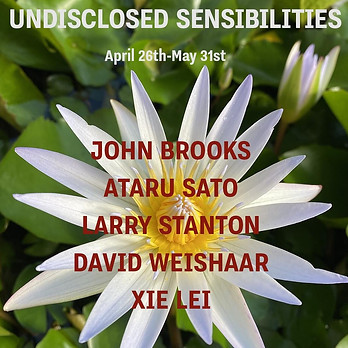
flyer by @matteocallegaristudio
undisclosed sensibilities
April 26 to May 31
opening on April 26 from 6 to 9 pm
Dispersed across the panoramic views neighboring flatmarkus hangs a selection of intimate portraits by John Brooks, Ataru Sato, Larry Stanton, David Weishaar and Xie Lei.
To the perceptive viewer, a good portrait feels like coyly waving back at someone only to turn around and realize they weren’t motioning at you in the first place: awkward and coincidentally intrusive. Gawking at portrait paintings is to find oneself caught up in a duel. More clumsy than necessarily violent, two conflicting wills coalesce. The first will is that of the portrayed protagonist, who, sensing their own mediation, inevitably and by nature attempts a change in posture, facilitating a degree of influence on their portrayal. The second will is that of the portraitist, concerning itself with expressing what it is they want to portray. Consciously or subconsciously, these separate ambitions end up in competition, the resulting portrait containing undiscernible effects from both participants in this duel. They’re not differently intentioned, least of all necessarily opposed, but no singular finished artwork comes in two variations – only one snow covered ground for differing paws to mark their trail. You end up plunged between the gazes of two people, unsure if they’ve noticed you as well.
It's also true, however, that a great deal of portrait painting today is the interpretation of images rather than the depiction of real people in time and space. To realize a subject could have been portrayed based on preceding medial objectifications instead of some passionate 1:1 musing could misleadingly cut the edge off. Painters draw on a vast variety of reference points and base materials: from other artworks, photographs or illustrations, to stranger’s selfies and, more recently, the aestheticization of generated prompts. Like in all instances of representation, everything becomes meddled with impression, the resulting echo of which is an offer to view the world through the lens of someone else. But what is it that you’re viewing? A yet more pertinent assessment would be framing the real subject in any portrait as being the material manifestation of a relationship itself.
Portraiture, in that sense, is the impression of a mediated involvement between two actors most viewers have never met. It’s voyeuristic by default. Before you realize it, you’re not intruding on two people waving at one another from a certain spatial length, you’re actually between them as they stand or sit and secretly stare, or as they’re making out, or arguing; maybe they’re fighting, maybe you’re even walking in on them having sex, you could even feel one of them drifting, or be exposed to sensing their insecurities in relation to their counterpart’s portrayal. A gateway to escaping today’s avatar grid logic – intimate, in an old fashioned kind of way – to humanize a subject is to take away its lightness, to swing between other people’s relationship with every portrait you choose to unveil.
Daniel Moldoveanu
